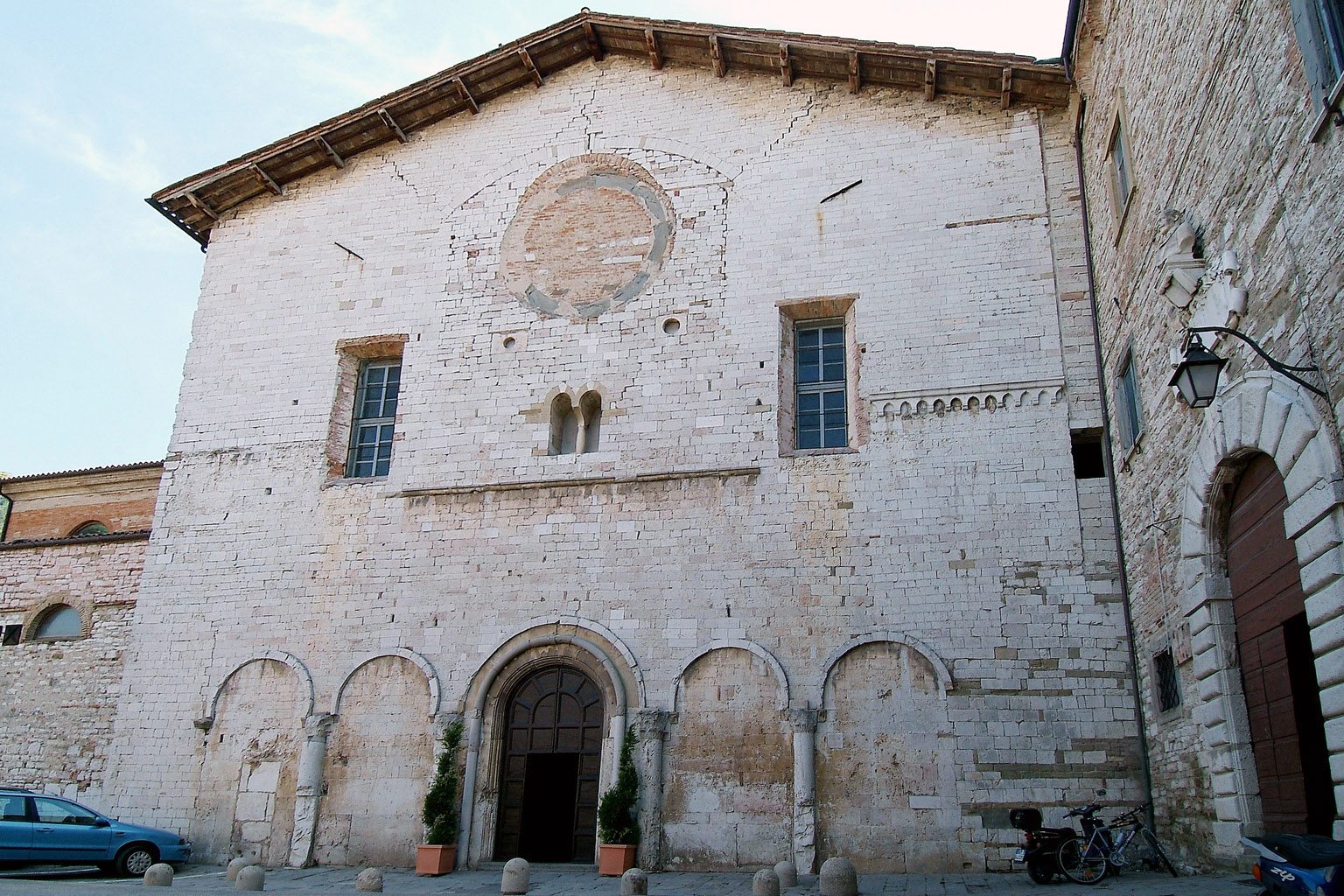La chiesa di San Pietro, dopo essere stata allargata dagli Olivetani che si insediarono nell’abbazia nel 1505, è stata completamente modificata, tuttavia la sua facciata mantiene interessanti elementi architettonici che rendono possibile avanzare delle ipotesi realistiche sull’origine.
Ci sono quattro colonne, parzialmente incorporate, che probrabilmente sorregevano una galleria aperta poi demolita e che sono state usate ancora per la chiesa consacrata nel XI secolo.
Le colonne sono adornate dal capitelli corinzi in cattivo stato di conservazione, scolpiti con tre cerchi sovrapposti di foglie d’acanto, la presenza dei quali può essere collegata alle tendenze bizantine che nel sesto secolo lasciarono altri segni nella città. Piccole mensole, inserite nella facciata, dove sono stati scolpiti animali fantastici e motivi arborei, sono le basi di sostegno degli archi cechi corrispondenti alla galleria aperta scomparsa.
Dopo l’intimo cambiamento del Rinascimento, l’aspetto del tempio è di buonissimo gusto, imponente , con elementi architettonici perfettamente bilanciati. la chiesa mostra alcuni affreschi di Raffaellino del Colle e di discepoli del Caravaggio, mobili scolpiti ed intarsiati, la maggior parte dei quali dai fratelli Maffei, artisiti eugubini di grande valore.
The Church os St. Peter, after having been enlarged by the Olivetanis which moved to the abbey in the 1505, has been completely modified. However, its facade maintains interesting architectonic trends which permit to formulate some realistic hypothesis on its origin.
There are four columns, partially built-in, which originally supported an open gallery then demolished and later on used for the construction of the church, consacrated in the XI century.
The columns are adorned with capitals badly preserved, carved into three overlapping circles of acanthus leaves, whose presence can be related to those byzantine tendencies which, in the sixth century, left other signs in the city. Small consoles are inserted in the facade, where fantastic animals and arboreal patterns have been carved, and give the basement to the arches supporting the gallery.
After the deep change during the Renaissance age, the style of the temple is perfect, imposing, characterised by perfectly balanced architectonic elements.
The church has at the inside some frescoes of Raffaellino del colle and Caravaggio disciples as well as carved and inlaid furnitures, most of which were worked by the Maffei brothers, artists from the region, of great value.
The Church os St. Peter, after having been enlarged by the Olivetanis which moved to the abbey in the 1505, has been completely modified. However, its facade maintains interesting architectonic trends which permit to formulate some realistic hypothesis on its origin.
There are four columns, partially built-in, which originally supported an open gallery then demolished and later on used for the construction of the church, consacrated in the XI century.
The columns are adorned with capitals badly preserved, carved into three overlapping circles of acanthus leaves, whose presence can be related to those byzantine tendencies which, in the sixth century, left other signs in the city. Small consoles are inserted in the facade, where fantastic animals and arboreal patterns have been carved, and give the basement to the arches supporting the gallery.
After the deep change during the Renaissance age, the style of the temple is perfect, imposing, characterised by perfectly balanced architectonic elements.
The church has at the inside some frescoes of Raffaellino del colle and Caravaggio disciples as well as carved and inlaid furnitures, most of which were worked by the Maffei brothers, artists from the region, of great value.
The Church os St. Peter, after having been enlarged by the Olivetanis which moved to the abbey in the 1505, has been completely modified. However, its facade maintains interesting architectonic trends which permit to formulate some realistic hypothesis on its origin.
There are four columns, partially built-in, which originally supported an open gallery then demolished and later on used for the construction of the church, consacrated in the XI century.
The columns are adorned with capitals badly preserved, carved into three overlapping circles of acanthus leaves, whose presence can be related to those byzantine tendencies which, in the sixth century, left other signs in the city. Small consoles are inserted in the facade, where fantastic animals and arboreal patterns have been carved, and give the basement to the arches supporting the gallery.
After the deep change during the Renaissance age, the style of the temple is perfect, imposing, characterised by perfectly balanced architectonic elements.
The church has at the inside some frescoes of Raffaellino del colle and Caravaggio disciples as well as carved and inlaid furnitures, most of which were worked by the Maffei brothers, artists from the region, of great value.
The Church os St. Peter, after having been enlarged by the Olivetanis which moved to the abbey in the 1505, has been completely modified. However, its facade maintains interesting architectonic trends which permit to formulate some realistic hypothesis on its origin.
There are four columns, partially built-in, which originally supported an open gallery then demolished and later on used for the construction of the church, consacrated in the XI century.
The columns are adorned with capitals badly preserved, carved into three overlapping circles of acanthus leaves, whose presence can be related to those byzantine tendencies which, in the sixth century, left other signs in the city. Small consoles are inserted in the facade, where fantastic animals and arboreal patterns have been carved, and give the basement to the arches supporting the gallery.
After the deep change during the Renaissance age, the style of the temple is perfect, imposing, characterised by perfectly balanced architectonic elements.
The church has at the inside some frescoes of Raffaellino del colle and Caravaggio disciples as well as carved and inlaid furnitures, most of which were worked by the Maffei brothers, artists from the region, of great value.



Comment (0)